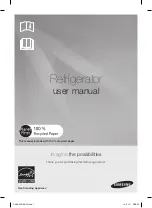
For all models
1. Disconnect the power supply unit.
2. Fix an approved self –threaded line extraction valve to the process tube.
Connect the refrigerant recovery system
to the valve.
Run the recovery system, open the line extraction valve and allow the coolant pass to an approved
type tank.
3. Remove compressor motor terminal conductors.
4. Remove the mounting clamps and washers.
5. Once the system is completely discharged, interrupt suction and discharge the lines as close to the compressor as
possible. Leave just enough tubing to stop up and seal the defective compressor.
6. Plug or close the system tubing with adhesive tape to avoid entrance of humidity and air to the system. Take away
the non-working compressor and transfer the mounting parts to the new one.
7. Drop escapes the new compressor maintenance load (slowly, to avoid oil discharge).
8. Install the new compressor exactly as the original.
9. Change the suction and discharge line positions and line them up with the new compressor. If they are too short, use
more tubing length. Joints should overlap at least the tube diameter to leave enough surfaces and remain well
welded. Clean and mark the area where tubing will be cut and use a tube cutter. This operation must be as fast as
possible to avoid entrance of humidity and air to the system. (NOTE: If the low side process tube is too short, weld
four inches tube with silver welding).
10. Weld all connections as per the welding procedure already detailed.
11. Remove the drying filter and install a new one in the condenser exit. Evacuate and load the system using the
procedure recommended in this section under the title “Evacuation and reload”.
12. Re - connect the conductors to the compressor terminals as indicated in the refrigerator connections diagram.
Cyclic Defrosting Models (one door)
The service of manual defrosting evaporator and the set of capillary tube and suction line are carried out as one set.
1. Disconnect the electric current unit.
2. Take away the defrosting water tray and the evaporator door and dismount the control thermostat sensor from the
evaporator.
3. Fix an approved self - threaded line extraction valve to the process tube.
Connect the refrigerant recovery system
to the valve.
Run the recovery system, open the line extraction valve and allow the refrigerant pass to an approved
tank.
4. Disconnect the drying filter capillary tube and the compressor suction line. Rotate the condenser to one side and take
away the cabinet entrance hole sealer.
5. Remove the evaporator mounting screws and take them away by the front of the cabinet.
6. Install the replacement evaporator set in the cabinet by reversing the procedures order.
7. Connect the suction line to the compressor and weld the joint.
8. Remove the original drying filter and install a new one in the condenser exit. Evacuate and load the system using the
procedure recommended in this section under the title “Evacuation and reload”.
9. Re -assemble the unit. All materials must be re – installed where lines pass through the cabinet.
HOW TO REPLACE THE CONDENSER (IN ALL MODELS)
1. Disconnect the electric current unit.
2. Fix an approved self - threaded line extraction valve to the process tube.
Connect the refrigerant recovery system
to the valve.
Run the recovery system, open the line extraction valve and allow the coolant pass to an approved
tank.
3. Disconnect the two condenser lines and take away the condenser from the cabinet rear part.
4. Install the replacement condenser in the cabinet rear part.
5. Connect the lines with sleeves and weld. Don’t try to stamp the condenser steel lines in heat.
6. Remove the original drying filter and install a new one in the condenser exit. Evacuate and load the system using the
procedure recommended in this section under the title “Evacuation and reload”.
PAGE. C6
















































